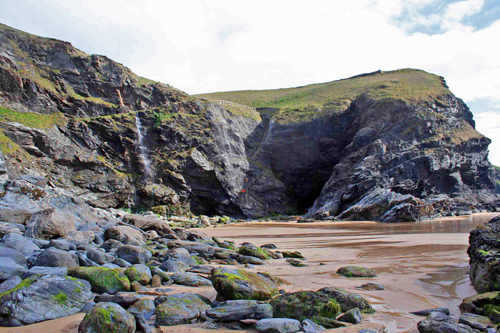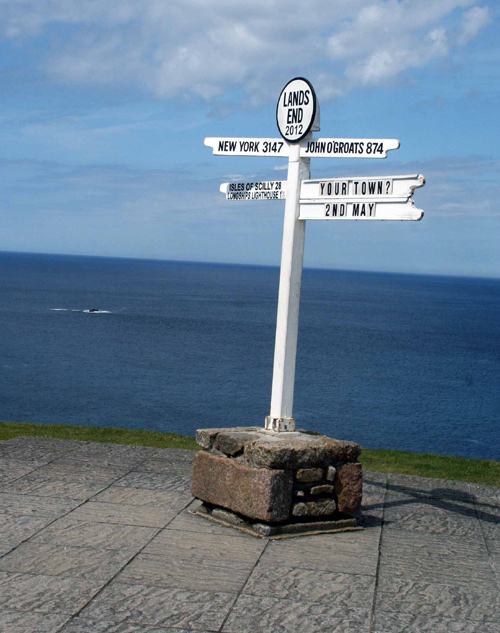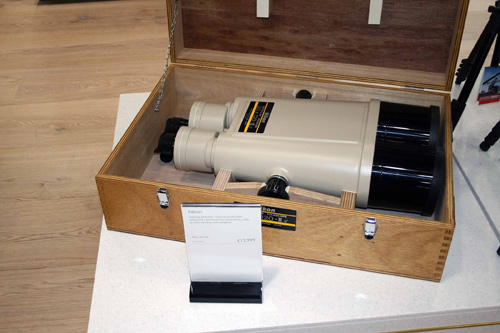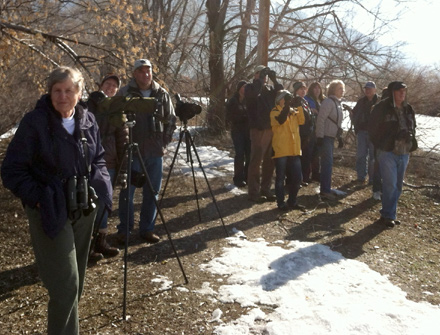Utah County Birders Newsletter
|
 |
Contents
March Meeting
Upcoming Field Trips
Captains Log
Bird of the Month
Field Trip Report
- East Bay, Provo
Backyard Bird of the Month
February Hotline Highlights
Newsletter is now
Online Only
MARCH MEETING:
Thursday, March 14th,
2013 - 7:00 PM
Kristen Ellis, a graduate student at BYU, will be presenting her master's thesis
work titled "Snowy Plover Nest Survival and Habitat Use
in Utah" at our March meeting.
Meet at 7:00 PM at the Orem Public Library - 58 North State Street, Orem.
We meet downstairs.
------------
Note - meetings will be held at the Orem
Public Library while the Bean Museum is under construction.
16 March 2013 (Sat): Skipper Bay & Airport Dike. 1/2 day trip - Led by Bryan Shirley. Meet at 8 AM at the Skipper Bay Trailhead. Drive to the west end of Provo Center Street, before entering the State Park turn right, then turn left at the T.
30 March 2013 (Sat): South Utah County. 1/2 day trip - Led by Dennis Shirley. Meet at 7 AM at the Walmart in Payson.
Possible future trip - I'm thinking about
scheduling a weekend club field trip to Monterey or Half Moon Bay in August or
September to go on a Pelagic birding trip, and I'd like to know how many people
would be interested. Email keeli.marvel@gmail.com
if interested. A list of potential trip dates and pricing can be found here
http://www.shearwaterjourneys.com/schedule.shtml or
http://www.montereyseabirds.com/.
We are actively recruiting people to lead local half-day field
trips, any time, any place. If you would like to lead a field trip or if you
have any ideas for this yearís field trips, please contact Bryan Shirley at -
bt_shirley@hotmail.com
February Captains Log
by Keeli Marvel
 |
|
The
biomes at the Eden Project |
 |
|
The
Bedruthan Steps on the Cornish coast |
 |
|
The sign
post at Land's End. Only 3,147 miles to New York! |
 |
|
The most expensive pair of
binoculars I've ever seen. Yes |
Birding England Part 2:
After we spent a couple of days relaxing and celebrating May Day in Padstow, UK,
we set off on a series of day trips around the Cornish peninsula. Our first trip
was to a place called The Eden Project, which is a series of biomes (big
bubble-shaped greenhouses) where different climates and their representative
plant communities have been grown. There are desert, rainforest, and
temperate/Mediterranean biomes where you can see all kinds of different plant
species and learn about how different cultures have evolved to live off those
plant species, about some of the threats facing those habitats, and ways to live
more sustainably. Outside the biomes there are also a series of gardens you can
walk through, and a performance area where they hold concerts and other
performances in the summer. In the gardens I got great looks at Blue Tits and
Eurasian Goldfinches. Some wild birds had managed to get into the biomes, and
inside I saw more Robins (the European kind), Blackbirds, and a great view of a
Dunnock. The Eden Project is well worth the visit, and I highly recommend it to
anyone traveling in the area.
Following our visit to the Eden Project, we returned to Padstow via the scenic
route along the western coast, stopping at a place called the Bedruthan Steps.
It is a site owned by the UK National Trust (sort of like our national monument
or national park system). The cliff faces along the ocean here are very steep
and drop off sharply into the ocean, and a series of really steep steps have
been carved into the cliff face. The wind and the rain (which never really quit
the entire trip) were picking up fairly well at this point, but I managed to
find a few Swifts (single word name again) being blown about the cliff faces. We
climbed down the very steep steps (not for the faint of heart) to the beach
where I found a Rock Pipit hopping around among the rocks. Funny how that works!
It was interesting to me to discover that they actually have not one, but four
different species of pipits that occur regularly in the UK. Another interesting
note is that the fluctuation in tides in several places along the southwestern
coast of England is so great that there at the Bedruthan steps the beach
actually disappears completely at high tide. It could definitely ruin your day
if you lose track of the time and get stuck down there with the tide coming in!
Further up the coast from the Bedruthan Steps in a place called Watergate I saw
some Whimbrels and Curlews (no fancy names here) in a small flock in a grassy
field along the coast. One drawback of birding along country roads in England is
that the roads are narrow and often bordered by large hedges, which makes
pulling over to check out birds along the road both unsafe and often impossible.
Our next day trip we ventured out even further, starting the day at Landís End,
the westernmost point in England. Landís End is a great place to see pelagic
birds, and a few bird species, like the Great Black-backed Gull, are known to
nest there. The Royal Society for the Protection of Birds (RSPB), the equivalent
of our Audubon Society in the UK, has a permanent educational site set up at
Landís End, and they were there with the scopes ready to point out some great
birds for me. I got to see a European Shag, a species that is from the same
family and closely resembling our cormorants, nesting Great Black-backed Gulls,
a Wheatear (also called Northern Wheatear Ė a smallish thrush), Jackdaws (a
smallish crow-like bird with a gray collar), and Starlings, which funny enough,
are not doing so well in their native country. Maybe we need to export a few of
ours back to bolster their population? My time at Landís End was limited, but I
was told that during migration itís not uncommon to see some fantastic pelagic
birds such as shearwaters, pomarines, and skuas there.
After Landís End we drove across the country to the opposite coast to visit St.
Michaelís Mount, a small island off the east coast with a castle on it. Itís not
often you can say you drove from the west coast to the east coast of a country
in a single day! St. Michaelís Mount is another UK National Trust site and is
accessed by boat at high tide or by a causeway that appears magically out of the
water at low tide. Can you imagine if we had ocean tides on the Great Salt Lake,
and our causeway disappeared under water a couple of times a day?! On the hike
up a steep cobblestone path to the castle I heard, and then located, a Wren (no
fancy names here either), and a few more species Iíd seen before.
Following our visit to Landís End, we made a couple more stops on the way back
to Padstow, and I picked up a pair of White Wagtails at a place called
Smugglerís Tavern on the River Fal.
After our brief stay in Cornwall, we traveled back to London for a couple of
days and I didnít see any new species. Total trip species count was 43 species,
about half of which were life birds, which all things considered is pretty good
for a non-birding trip during the wettest spring the UK has seen in many years!
If youíve read through this far, thanks for sticking with me! Next month Iíll
hopefully have some great stories about birding in Iceland. Until then, hope to
see you all out and about birding!
|
|
|
Photo by Bryan Shirley |
Bohemain Waxwing (Bombycilla garrulus)
by Bryan Shirley
Bohemian Waxwings are one of my favorite winter birds in Utah. They are probably
my favorite at least in part because of how hard I had to work to get my first
one in Utah. I really started birding in Utah a little over 10 years ago. Every
winter I would scour through every flock of Cedar Waxwings I could find hoping
for a Bohemian, but never could find any. Bohemian Waxwings vary from rare or
not even present some winters to fairly common other winters. I was in a stretch
of ďrareĒ years and I tried for several years before I finally found one. The
last few years have been much better for Bohemians, but this year is probably
the best I have had in Utah. It seems like they are present in most flocks of
Cedar Waxwings and lately I think I have a lot more Bohemians than Cedars!
Bohemian Waxwings are much larger than Cedar Waxwings. Sibleyís has the length
as 8.25 inches, which is only 1 inch longer than a Cedar, but the weight is
nearly double. Besides the obvious size difference, they have white and yellow
markings on the wings and dark rufous undertail coverts, both characteristics
that make them easy to ID. They form large flocks and resemble starlings when
they are flying around. They are quite noisy and voice can be helpful in
locating them.
If you havenít seen them around yet, get out quick because they will be leaving
soon and who knows if they will be back next winter. They like fruit and
berries, so orchards or areas with a lot of Russian Olives are good places to
look. There was a flock seen at the Kuhni Wetlands on our field trip a couple
weeks ago and there are a couple hundred along the road at the Goshen Warm
Springs as of March 1st.
If you would like to write an article for the Bird of the Month, please contact
Eric Huish -
erichuish@gmail.com
Click here for past 'Birds of the Month'.
 |
Field Trip Report
East Bay, Provo - February 18th, 2013
by
Eric Huish
On Monday (Feb 18th) 13 Utah County Birders met for
a field trip led by Keeli Marvel. We visited East Bay Golf Course, Kuhni
Wetlands and the Provo Cemetery. We met at the East Bay Sam's Club parking lot
where 30 Great-tailed Grackles greeted us.
Our first stop was at the cul-de-sac overlooking the night-heron island at East
Bay Golf Course. Highlights here were Wood Ducks, Cinnamon Teal, Canvasback,
Black-crowned Night-Herons and 3 Double-crested Cormorants. - Full Checklist
here -
http://ebird.org/ebird/view/checklist?subID=S13080455
We then walked down the trail along the canal into Kuhni Wetlands. There we got
great looks at a flock of about a dozen Evening Grosbeaks. A little farther down
the trail we found a flock of 60-100 Bohemian Waxwings. The waxwings gave us
great views at eye level and as close as 10 feet away. We couldn't find a single
Cedar Waxwing in the flock. In the pond at the end of the trail the American
White Pelican and Greater Yellowlegs that had been reported earlier were still
there. We also found a Hermit Thrush. Full Checklist here -
http://ebird.org/ebird/view/checklist?subID=S13080454
Provo Cemetery was pretty slow. We saw a few Red-breasted Nuthatches and a flock
of Cedar Waxwings flew over. Full Checklist -
http://ebird.org/ebird/view/checklist?subID=S13080321
February 2013
Lyle Bingham - Payson
This was a big day at my feeder about 3 weeks ago Wednesday: - 25 Spotted Towhees, 4 Black-capped Chickadees, 3 Northern Flickers, 10 Juncos. The Towhees are by favorite. I love how they dig through everything on the ground. And I dislike how they dump the contents of the feeder on the ground.
Yvonne Carter - Highland
It has been unusual to see our Northern Flickers hammering away in our
feeders in the early mornings instead of the trees; it has been waking me up on
the weekends. The feeder is on the level just below our second floor bedroom
window!
Jeff Cooper - Pleasant Grove
My favorite backyard bird experience for February was when I found about five
Bohemian Waxwings mixed in a small flock of Cedar Waxwings. I had seen small
flocks of waxwings off and on for weeks, but I always came up empty when trying
to find a Bohemian. Finally seeing them feeding in the flowering plum trees with
the Cedars was a real thrill.
Eric Huish - Pleasant Grove
White-winged Dove - saw it for a moment in the top of a tree in the
across the yard. Probably the same bird that visited last September and
has been hanging out at some feeders down the street.
Keeli Marvel - American Fork
My backyard (front yard) bird of the month is a flock of about 20 Bohemian
Waxwings. What a great year for this species!
Milt Moody - Provo
I've had a couple of Spotted Towhee with a little "spring" in their step,
milling around under my feeders.
Carol Nelson - Provo
The male Hooded Merganser came back for a visit and brought with him four
Ring-necked Duck pairs. The latter were my 76th yard species. Yeh!!
Leila Ogden - Orem
Mine has to be the Western Screech-Owl that has been coming to my owl
box.
Cheryl Peterson - Provo
American Kestrel - first time one was actually in my yard and not perched
on nearby telephone poles.
Leena Rodgers - Provo
Had a handsome American Kestrel hovering at my feeders just outside our
glass patio door. First time ever to see one in our yard. Put on quite a show!
Kay Stone - Lehi
Jim Strong and I have been feeding peanuts to a pair of Western Scrub-Jays
since about the first of October. We are Lehi neighbors.
Alton Thygerson - Provo
Spotted Towhee - Sometimes two of them.
Report your favorite backyard bird each month to Eric Huish at 801-360-8777 or erichuish@gmail.com
Newsletter Announcement. The Utah County Birders Newsletter is now online only.
We've decided to stop the regular paper "snail mail" version of the UCB Newsletter. This will save our club on Printing, Postage and Paper. If you would like an email notice each month when the Newsletter is posted online please send an email to Eric Huish at erichuish@gmail.com or subscribe to the ucbnet mailing list. To subscribe to ucbnet just send an e-mail to ucbnet-subscribe@utahbirds.org
We are willing to print the online version of the newsletter and mail it out to anyone who still wants a paper copy or who doesn't have internet access. If you know of anyone who enjoys the UCB Newsletter but doesn't have internet access please let Eric Huish or Keeli Marvel know and we will make sure they get a copy.